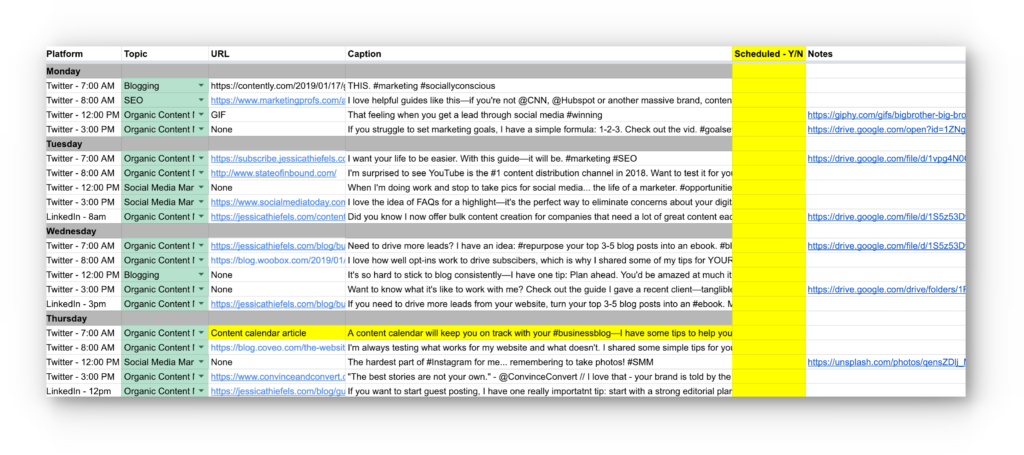A content calendar is typically used to plan your blog posts. It’s also your best friend as a small business owner or marketer. We all know how the blog writing cycle goes when you have a thousand other things on your mind: you create your strategy, get excited and then what? Then things get in the way; a new client opportunity comes up, your schedule gets packed, and suddenly your efforts (and excitement) disappear.
A few weeks later, you realize you haven’t published a blog post at all this month and you’re back at square one. Avoid the guilt and frustration of this cycle with a content calendar.
A content calendar is an organizational tool, typically a working document or spreadsheet, that is set up while creating a blog. It details the content you plan to publish over a time period. This could be a month or a year. If you don’t have a content calendar yet—you’re in luck. Learn about why you need it and then grab my free Quarterly Content Calendar Bundle at the bottom of the blog post.
Why Content Calendars are Important
We all know that content is an integral aspect of digital marketing. According to recent reports, 81 percent of companies with content marketing strategies in place can directly attribute revenue that is generated by content. What does that mean? Companies with a content plan are able to look back and see revenue, or other forms of value (I.E. leads), from that content.
Why might that be? Because a content calendar serves as a hub for your blog planning. This is valuable for a few reasons:
Accountability for publishing: You’d be shocked how much more likely you are to sit down and write a blog post when you already have a topic planned and chosen. This accountability leads to consistency in publishing, as well, since you need to actually write the post to get it live on your blog.
Easy collaboration: If you have multiple contributors, guest authors, or internal staff assisting with your content production, a content calendar is a central location to track all the moving pieces. Store your calendar on a cloud-based platform (like Google Drive), and all stakeholders can see and make updates in real time.
Cohesive branding: It’s easy to go off-topic when you’re choosing topics willy-nilly. A content calendar, and the checklist in my Quarterly Content Calendar Bundle, ensures that you’re staying focused on the topics that will drive your ideal customer to your site through search.
Long-term strategy at your fingertips: When you plan blog posts for 2 to 6 months at a time, you’re able to develop a long-term strategy. This makes it easier to bring in your business goals at a high-level, and ensure that your blog posts are actually getting you closer to where you want your business to go.
Consistency between blog and social: My social media theme for Instagram is based on the blog post I’m publishing that week. If you’re a financial advisor and know that you’re publishing a blog post on money goal-setting next week, you can start collecting the resources you need for social media assets when it goes live, like a branded checklist, video, etc.
Content Calendar for Blogging
Content calendars are traditionally used for blog planning. Even if you’re only posting once a month, a content calendar will help you forecast strategy and stay on schedule. If you have guest authors or contributors, or like to repurpose content regularly, you can include all that information here. This serves as a blog roadmap that eliminates guessing and allows you to execute more confidently.
How to Create a Blogging Content Calendar
Your content calendar layout will heavily depend on your overall content marketing goals. Here are some fields you can include in your content calendar:
- Article topics
- Keywords
- Assigned author
- Business focus/goal for post
- Due date and/or publishing date
- Link for live article
Tips and Tricks
- If you’re using a spreadsheet, use a separate tab for each quarter or cycle.
- Keep another separate tab for ideas. One of the more difficult aspects of keeping your pipeline full is ideation. Use your content calendar to record all story ideas or topics, even if they aren’t fully flushed out. When planning in the future, you have ideas to start with.
Content Calendar for Social Media
A content calendar can also be used to plan your social media efforts. Not only does this keep you organized, but it also means you’ll never miss important dates. National days might be silly, (#PiDay, #NationalMargaritaDay, etc.) but they trend on social, and when related to your industry, they can help you pick up followers.
A social media content calendar also ensures you’re focusing on a consistent mix of your top 3 to 5 topics. When your social media is laid out by week or month, it’s also easy to see if you’re posting too much of a type of media (memes, videos, quotes) or too little of something else.
How to Create a Social Media Content Calendar
While many scheduling systems (like Hootsuite or Buffer) allow for a calendar view, this is not the same as a content calendar. Use a separate tool to layout your social posts before scheduling to make sure you have the best mix each day and making plenty of space for promoting your own brand as well. As an added bonus, when you’re copying and pasting your posts into your scheduler, you have a second chance to catch mistakes or typos.
Your social media content calendar can include the following fields:
- Date and time of posting
- Platform (Facebook, Instagram, Twitter)
- Media (link, graphics, video)
- Copy for caption
- Topic
See an example of my social media content calendar (and the one you’ll find in the bundle) below:

Tips and Tricks
- You can create quarterly themes for your social media content calendar, but fill out and update your calendar on a weekly basis so you can be sure to include fresh articles and timely content.
- Include your 3-5 main topics as a dropdown menu (here’s a guide for how to do that). These topics should mirror the content that your audience craves in addition to your brand. For example, topics for a yoga studio could be: health and wellness, yoga news, community awareness, and pose basics.
- If you use a google spreadsheet for your calendar, have a separate shared media folder with images and graphics. Then link directly to the media that you would like to post in your spreadsheet. This is especially valuable if someone does the scheduling for you.
Content Calendar Templates
There are many free content calendar templates available online from nearly every marketing publisher. I’ve created my own Quarterly Content Calendar Bundle for you, so you can jump in with planning right away. The difference between mine and everyone else’s?
- Simplicity. I like to keep things straight forward. The more confusing, the less likely are to use it.
- Checklist for success: Your content calendar is only valuable if you know what it should include and look like. My checklist ensures each topic you choose will help you get closer to reaching your business goals.
- SEO: My super simple template includes one important section: SEO keyword. Each blog post should be paired with a keyword and this makes it easy.
- Extra resources: Find links to my extra blog planning and social media resources within the bundle.
[mailerlite_form form_id=5]



